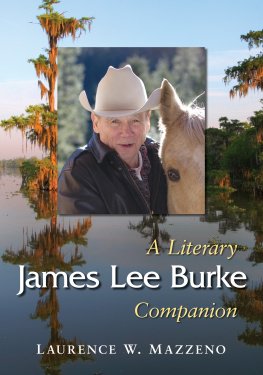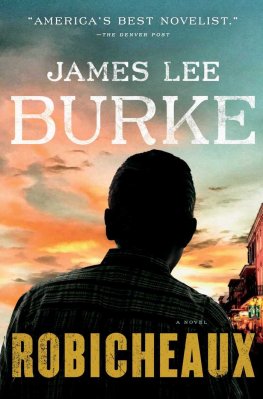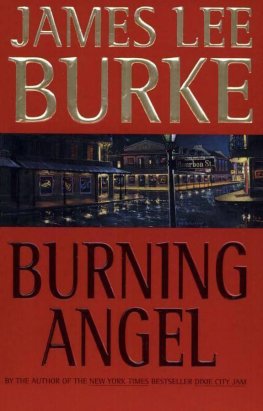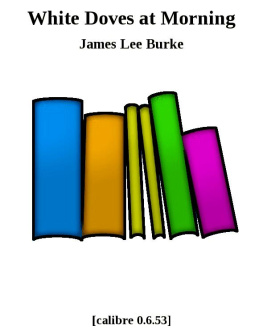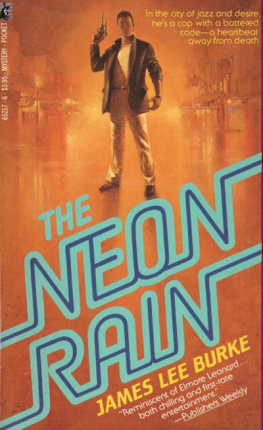
MCFARLAND LITERARY COMPANIONS
BY MARY ELLEN SNODGRASS
1.August Wilson (2004)
2.Barbara Kingsolver (2004)
3.Amy Tan (2004)
4.Walter Dean Myers (2006)
5.Kaye Gibbons (2007)
6.Jamaica Kincaid (2008)
8.Peter Carey (2010)
10.Leslie Marmon Silko (2011)
13.Isabel Allende (2012)
15.Brian Friel (2017)
BY PHYLLIS T. DIRCKS
7.Edward Albee (2010)
BY ERIK HAGE
9.Cormac McCarthy (2010)
BY ROCKY WOOD
11.Stephen King (2011)
BY TOM HENTHORNE
12.William Gibson (2011)
BY MARK CONNELLY
14.Saul Bellow (2016)
BY LAURENCE W. MAZZENO
16.James Lee Burke (2017)
James Lee Burke
A Literary Companion
LAURENCE W. MAZZENO
McFarland Literary Companions, 16

McFarland & Company, Inc., Publishers
Jefferson, North Carolina
LIBRARY OF CONGRESS CATALOGUING DATA ARE AVAILABLE
BRITISH LIBRARY CATALOGUING DATA ARE AVAILABLE
e-ISBN: 978-1-4766-3113-4
2018 Laurence W. Mazzeno. All rights reserved
No part of this book may be reproduced or transmitted in any form or by any means, electronic or mechanical, including photocopying or recording, or by any information storage and retrieval system, without permission in writing from the publisher.
Front cover photograph of James Lee Burke by James McDavid; background photograph of Louisiana Bayou 2018 Denis Tangney, Jr. (iStock)
McFarland & Company, Inc., Publishers
Box 611, Jefferson, North Carolina 28640
www.mcfarlandpub.com
To my parents and my sisters,
all proud Louisiana natives
Acknowledgments
I want to thank the staff at Alvernia Universitys Frank A. Franco Library, especially Roberta Rohrbach and Derek Smith, who tracked down hard-to-locate resources, and James Lee Burke, who responded generously to my request for informationand wrote the wonderful fiction that inspired me to compile this Companion.
Preface
This book has been years in the making. I first read James Lee Burke in 1988 at the suggestion of my Naval Academy colleague Neil Berman, who knew I was from New Orleans. The Neon Rain got me hooked, and I read each succeeding novel as it was published. By the time I read In the Electric Mist with Confederate Dead, I was convinced Burke was not simply an accomplished writer of genre fiction; his work showed clear affinities with the best of Southern literature. Sometime after I retired from Alvernia University in 2005, I read the fiction Burke had published before his Robicheaux novels put him on the best-seller list. As a Southerner I felt almost compelled to write something about an author whose work deserved critical attention. So in 2010 I began gathering materials for a book, not knowing what shape it would take.
Midway through my efforts to collect everything written about Burkes fiction, I read Barbara Bogues James Lee Burke and the Soul of Dave Robicheaux and Leonard Engels essay collection, A Violent Conscience: Essays on the Fiction of James Lee Burke, both published by McFarland. Some research led me to their Literary Companion series, so I checked out volumes on Cormac McCarthy and Amy Tan. A brief perusal of these well researched and elegantly written books convinced me that the Companion series would be the ideal vehicle for my work. Fortunately, McFarland agreed, and work on James Lee Burke: A Literary Companion began in earnest in 2014.
Like other books in the Literary Companion series, this one includes a brief biography and a checklist of the authors major works. I have used the Introduction to argue that Burke should be considered an important writer who has used the mystery genre as a vehicle for exploring important issues about what fellow Southern writer William Faulkner (1950) called the problems of the human heart in conflict with itself. The major section of this Companion, organized alphabetically, includes entries for each of Burkes novels and short story collections published as of 2016 as well as entries for recurring characters. When writing about the fiction, I have offered an assessment of its initial reception, given some idea of its place in a recurring series or described its relation to other works in Burkes canon, and offered an analysis of theme, technique, or social commentary. For stories based on the history of Burkes family, I have pointed out parallels without suggesting that the fiction is disguised autobiography. When discussing recurring characters, I have explained how they grow or change over the course of two or more novels and how Burke uses them to elucidate some of the values he cherishes.
Additionally, there are entries discussing people, places, and events important in the fiction. For example, Burkes novels and stories offer extensive commentary on the Civil War and Southern history; he uses the city of New Orleans and Iberia Parish (the equivalent of a county in other states) not only as recurring settings but also as exemplars of significant themes. My discussions provide information on these events and places, followed by an assessment of Burkes use of them. I have included entries on Burkes style, techniques, and use of literary devices as well as brief descriptions of genres to which Burkes fiction has been assigned by reviewers and critics.
For convenience I have used the Chicago Manual of Styles author-date system of documentation. Works quoted in the text are identified by the last name of the author or editor and the year of publication; a corresponding entry can be found in the Works Cited list at the end of this Companion. I have quoted from dozens of reviews and interviews. I have done so for two reasons. First, academic scholarship on Burkes fiction, while growing, remains modest and does not address all of his novels and stories. Second, the number of reviews is substantialeven his earliest work was noticed in several publicationsand much can be learned from reading them. Direct quotation allows me to provide an extensive list of resources for those interested in learning what contemporaries thought of Burkes work. When quoting from Burkes novels and stories, I have used abbreviations that are listed in the Abbreviations.
In keeping with the general format of books in the Literary Companions series, most entries are followed by See Also and Further Reading headings. Under the first I have listed related entries in this Companion. Books, articles, and reviews under Further Reading will aid users in learning more about an entry. Not all relate directly to Burkes fiction, however; some cover topics in greater detail or from a wider perspective than one might find in an individual novel or story. For example, Further Reading for The Tin Roof Blowdown lists books dealing with Hurricane Katrina and its aftermath as well as publications that address Burkes novel specifically. Wherever possible, I have listed scholarly or popular books and articles. In publications where discussion occurs within an essay or chapter that deals with additional material, I have included specific page references in brackets to point readers to the most relevant critical commentary. For example, Linda Holland-Tolls essay on the supernatural in the Robicheaux series is under Further Reading for supernatural. Because it contains an extended discussion of Jolie Blons Bounce, it is also under Further Reading for that entry with the pages addressing this novel in brackets. On occasion, I have included a review when no appropriate book or article could be located. To save space, works listed under these headings are not included in the Works Cited unless I have quoted from them.
Next page
